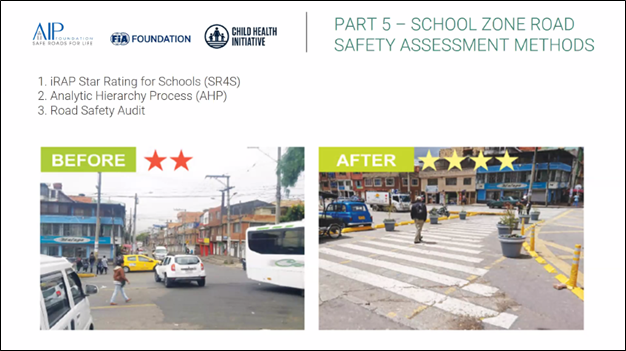Children around the world face significant dangers on the roads, especially when traveling to and from school. In Vietnam alone, statistics from the National Traffic Safety Committee show that road traffic accidents involving children under 18 accounted for 10.63% of all crashes in 2021. With over 17 million children commuting between home and school 2-4 times daily, enhancing road safety measures for their school journeys is becoming increasingly crucial.
The AIP Foundation, an SR4S Lead Partner, has been heavily involved in improving school zone safety in Vietnam since 2005. Drawing on the successes and insights from their well-known Slow Zones, Safe Zones programme, along with international case studies, the AIP Foundation, in partnership with the University of Transport and Communications (UTC), the Ministry of Transportation (MOT) of the Socialist Republic of Vietnam, and the FIA Foundation, has developed the Safe School Zones Guide (SSZ Guide).
Technical assistance for the development of the guide was provided by the Global Road Safety Partnership and the International Road Assessment Programme (iRAP). Earlier this year, a significant milestone was reached with the formal presentation of the SSZ Guide to the Ministry of Transport (MOT) for the first time. Additionally, the English version of the Guide was officially launched on April 11, 2024, to introduce it to a global audience.
The SSZ Guide is tailored to support stakeholders involved in various school zone-related projects. Whether it’s the construction of new schools, modifications to existing ones, road constructions or upgrades near school zones, or safety assessments pertaining to school investments, new constructions, and renovation projects, this guide serves as a valuable resource. While the design standards within the guide adhere to Vietnam’s regulations, its definitions, overarching planning and design principles, and essential traffic infrastructure for school zones can offer valuable insights to road engineers, policymakers, and entities in pertinent sectors worldwide.
The SSZ Guide comprises several key sections aimed at enhancing road safety in school zones:
- Part 1 provides an introduction, outlining the guide’s objectives, target audiences, and purposes.
- Part 2 offers an overview of road traffic safety in school zones, defining terms and highlighting major risks to children while presenting exemplary safe school zone models.
- Part 3 discusses basic principles for planning school zones to meet safety standards in various planning contexts.
- Part 4 delves into the design of safe school zones, covering principles, improvement steps, and technical measures for enhancing road safety.
- Part 5 introduces methods for assessing road safety in school zones, providing a comprehensive framework for stakeholders involved in school zone planning and management.
The SSZ Guide recommends SR4S as a method of road safety assessment in school zones due to its automation and high accuracy. By providing objective results, SR4S minimizes the need for subjective evaluations by assessors. Moreover, assessments conducted by trained surveyors enhance the credibility of the results. SR4S has been employed in various projects in Vietnam, including the pilot study for the SSZ Guide and other initiatives such as Walk This Way, Slow Zones, Safe Zones, AI&Me: Empowering Youth for Safer Roads, assessing over 200 schools across the nation.


